Games with Models, April 28 Data
Today’s COVID-19 data release from the state government was along the same lines. The rate of increase of new cases continued to drop.
Today’s COVID-19 data release from the state government was along the same lines. The rate of increase of new cases continued to drop.
Despite a slight uptick in the number of hospitalizations, today was a very positive day for Rhode Island’s COVID-19 report.
The second essay on my newly reconstituted Dust in the Light observes that journalists, local activists, and all of us trying to go about our lives are making it clear that we really do live in different universes
Rhode Island took another step in the right direction with Sunday’s COVID-19 report, with hope rising that April 21 was the peak for hospitalizations.
Today’s COVID-19 report for Rhode Island came with a mildly better turn.
Although it’s still looking plausible that Tuesday was RI’s peak for COVID-19 hospitalizations, the steady increase in total cases remains a concern.
If we’ve found the steady rate of COVID-19 infections for our current level of lockdowns, that would point to the differences in models as well as the need to figure out what government is supposed to be for.
There may still be a few readers out there who’ll remember that I got my blogging start with a site called Dust in the Light nearly 20 years ago. When a few of us began Anchor Rising a couple years later, I tried to keep up Dust in the Light for a while, with more of a national and social-issue. Then, not long after the Ocean State Current started, time just didn’t allow for all that differentiating of content.
Nowadays, a little bit of time freed up, but more important, there are some things I want to write about that just don’t fit on the Current. Sometimes I’ve tried to force them in, but the fit isn’t quite there.
So, I’ve revived Dust in the Light for philosophical and theological essays and maybe the odd bit of stylistic writing. Not only are these styles and topics that I miss as a writer, they are also increasingly missing from the public square, from what I’ve seen. (It doesn’t have to be a solo effort, by the way, so if you want to send me content, I’ll consider it and, per my usual practice, draft you as an independent contributor as soon as I think it’s reasonable.)
My first essay is “Coronavirus Earth,” about the ways in which life under COVID-19 has been “clarifying many ideas with experience that were previously abstract.”
As data is corrected and Rhode Island rounds the peak for COVID-19 cases and hospitalizations, it may be time to adjust the projection methodology.
Given restrictions on gatherings, RI Women for Freedom & Prosperity have moved our forum “how women can lead the way in restoring moral order and economic prosperity” onto Zoom this Saturday:
First, an inspiring speech about why women should become engaged in the political process, from Jennifer Braceras, director of the Law Center for the nationally renowned Independent Women’s Forum. Jennifer, a lawyer and former Commissioner of the US Commission on Civil Rights and Trustee for the Univ. of Massachusetts, is a political columnist.
Next, with advocacy training by the nationally renowned Grassroots Leadership Academy, this motivational and instructional leadership forum will introduce women to some of the tools necessary become involved in public policy or politics, with vital tips on how to effectively advocate for reform.
This portion of our women’s leadership forum will be led by by LeeAnn Kapanick, former field operative for Americans for Prosperity, who has spearheaded numerous grassroots and political efforts in Pennsylvania and nationally. LeeAnn, a fourth-generation farmer who regularly rides American Quarter Horses, is a graduate of Penn State University and is an alumna of the Anne B. Anstine Excellence in Public Service Series.
The emerging question when it comes to the daily data releases for COVID-19 in Rhode Island continues to be: which metric should we be watching? Today, the number of cases continued to outstrip my prediction as did, tragically, the number deaths. However, the number of hospitalizations, which is the focus of my model, went down one from yesterday and was, therefore, substantially lower than my prediction.
The reason the model I developed shows what looks like an upward correction and the predicted decline spreading out has to do with the number of cases. The rate of growth is slowing, but not as quickly as it had been, which means there are more “active” cases than expected, and that’s the foundation of my hospitalization predictions. (By the way, here’s the original post of this series, with my methodology.)
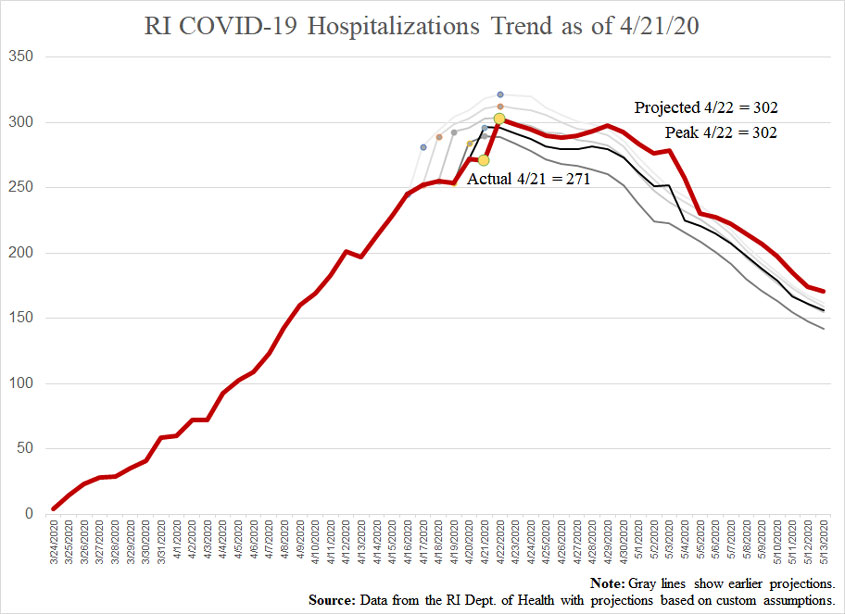
The three key metrics now look as follows:
The level of power Governor Raimondo is claiming for herself is huge, and it is noticeable in subtle ways. For example, in an article on GoLocal about how she’s had her hair done even as Rhode Islanders are prevented from doing the same, the governor tells “hairdressers, barbers, gig economy workers” to file for unemployment “until I can find a way to get you open safely.”
Notice that it’s all up to her. She is going to find a way. She is going to tell you when you can work again. If she is going to do that, she should give Rhode Islanders detailed information and data about how she is making decisions so we can judge for ourselves whether what she is concluding is reasonable or ridiculous.
Of course, because the trend of this weekend was a leveling-off of COVID-19 hospitalizations, it was tempting to think we’d already hit the peak, and today’s increase to 272 people in the hospital proves that wasn’t so. Nonetheless, the increase was still less than my model had predicted.
(It bears repeating that these projections are based entirely on recent trends, so there isn’t any assessment of how viruses spread.)
For today, the model had projected 284 hospitalizations, and the actual number turned out to be 272.
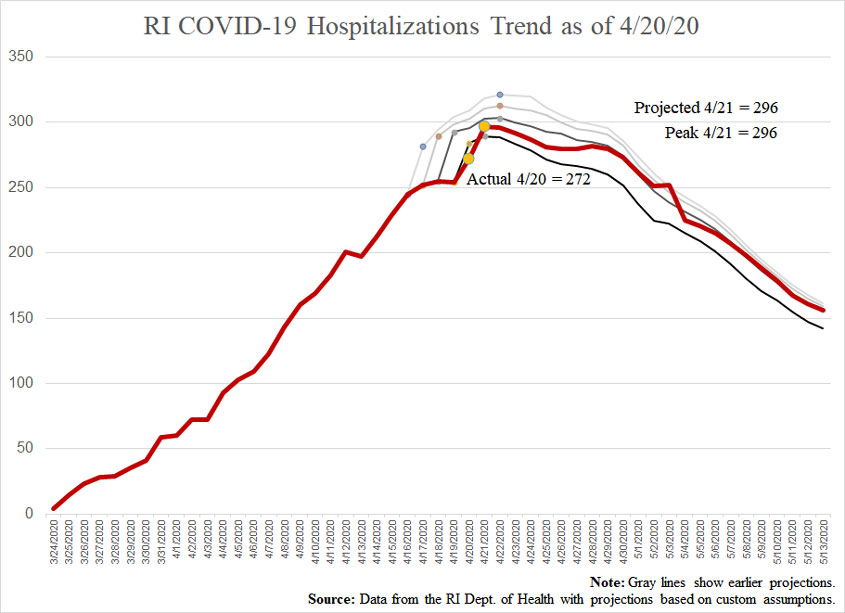
Here’s how the one-day predictions stacked up to reality and where they’re going next:
Naturally, to the extent that cases can follow a different trend than hospitalizations and deaths, it’s great to see the latter two going down. Increased testing would tend to mean we’re recording more cases leaning toward the less-serious side and would also tend to make the model overestimate for hospitalizations and deaths.
These trends move the projected peak of active cases to 4,082 tomorrow, with 1,067 Rhode Islanders’ having recovered.
Hopefully the slight downturn in COVID-19 hospitalizations in Rhode Island reported today will mark this as the start of the down slope in infections. The model I’ve been following suggests we’ll have a couple more days of increases, but that trend is affected by the fact that I’m still capturing a few days of large increases in my averages.
As it was, for today, I’d projected 293 hospitalizations, but the reported number was actually down one, to 254. The following chart reflects the updated projections.
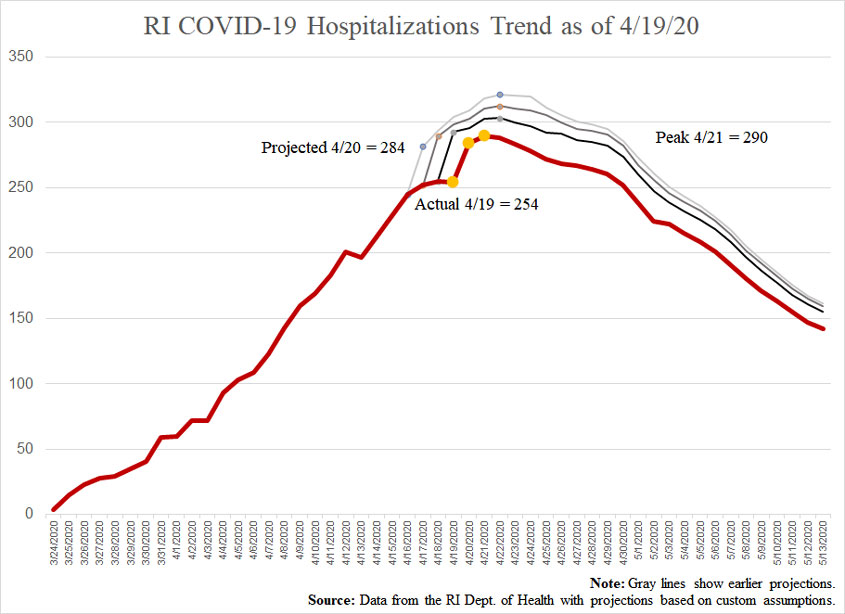
Broadening to the three key metrics we’re all watching, this is how we’re looking:
It is more than disappointing to see the numbers of deaths coming in higher than projected even as other metrics slow down. That could just be the fact that the disease worked its way into some high-risk populations, so recovery will lag.
Another important point as the governor starts talking about what we’ll have to see before she’ll permit us to get back to something closer to regular life: If she bases her judgment on the number of actual cases, that’s the wrong measure. Total cases are going to keep going up for the foreseeable future (although current trends put them hitting a plateau in mid-May if we don’t loosen restrictions.
This is why it is important for people in power to start talking about active cases. When it comes to the spread of the disease, somebody who has had the disease and recovered will almost certainly be a walking stopper of the disease. It is amazing that nobody in Rhode Island is talking about how many have recovered.
My model has active cases peaking at 3,902 on Tuesday, with an underlying 1,065 people having recovered. The question the governor should be encouraging us to consider and discuss among ourselves (this being a government of, by, and for the people, you know) is what should be tolerable.
If we focus our energies on protecting at-risk people, then we can start to open up for everybody else and loosen or tighten our behavior to stay within an acceptable margin for hospitalizations. For example, if COVID-19 hospitalizations fall between 150-200 people at any given time, with only a few deaths attributable to the disease each day, is that too many, or should the acceptable threshold be higher?
Keep in mind that our current solution is creating a breeding ground for social diseases and deaths associated with those.
I noticed something interesting today. Thus far, Governor Raimondo’s daily briefings on the coronavirus have produced a flurry of social media posts and articles emphasizing three metrics: cases, hospitalizations, and deaths. Over recent weeks, some journalists have said that hospitalizations is the key trend to watch, and when the governor gave a little bit of transparency into the data behind her decision-making, she released a chart projecting… yes… hospitalizations.
Well, while it may only be a temporary reprieve, the increase in hospitalizations has slowed way down in the past couple days, and suddenly that is no longer the subject of concern. Some local reporters have even switched to emphasizing only cases and deaths.
But that’s not how informing the public about trends is supposed to go. We shouldn’t follow a metric until it stops being interesting and then switch to something more topical.
So, to keep up the series of posts projecting hospitalizations in Rhode Island, here’s the chart based on today’s new data. Yesterday’s projection was for us to have 289 people in the hospital today, and the reported number was actually 255. It would be reasonable to suggest that the projection for tomorrow, of 293, is once again too high, but this model measures trends over the past week so as to be less volatile.
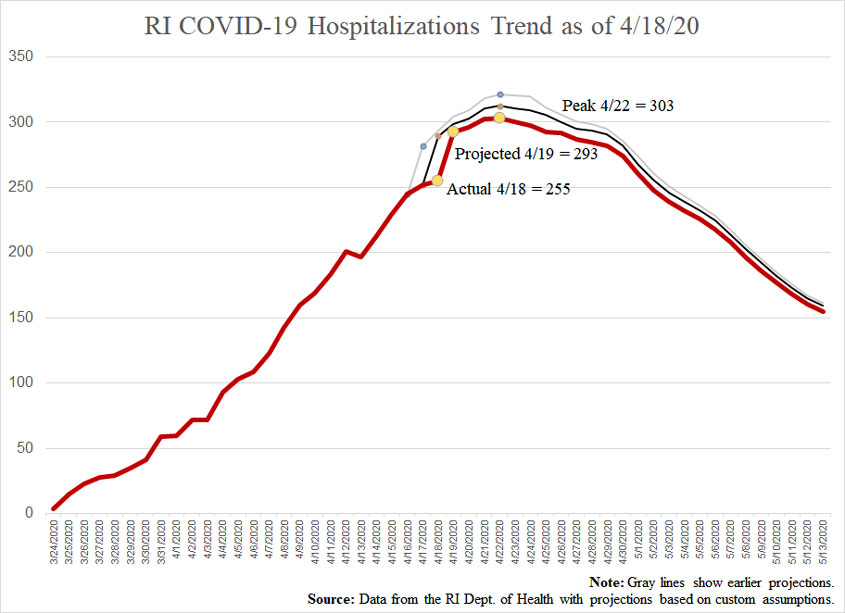
Based on the new numbers, the model suggests that tomorrow’s report will be:
Unfortunately, although hospitalizations have been coming in below estimates, cases and deaths have been a little higher than projected.
Turning back to hospitalizations, the three models currently suggest they’ll peak as follows:
It occurs to me that daily comparisons of COVID-19 predictions versus reported numbers would be more useful if the model is adjusted soon after the daily data dump, so I’ll put up two of these posts today. This one adjusts my model for yesterday’s numbers, and this afternoon, I’ll put up another based on whatever news the governor reports.
For April 17, I had predicted 282 total hospitalizations (as in, people currently in the hospital). The reported number was 252. Adjusting for the reported numbers of cases and hospitalizations produces the following:
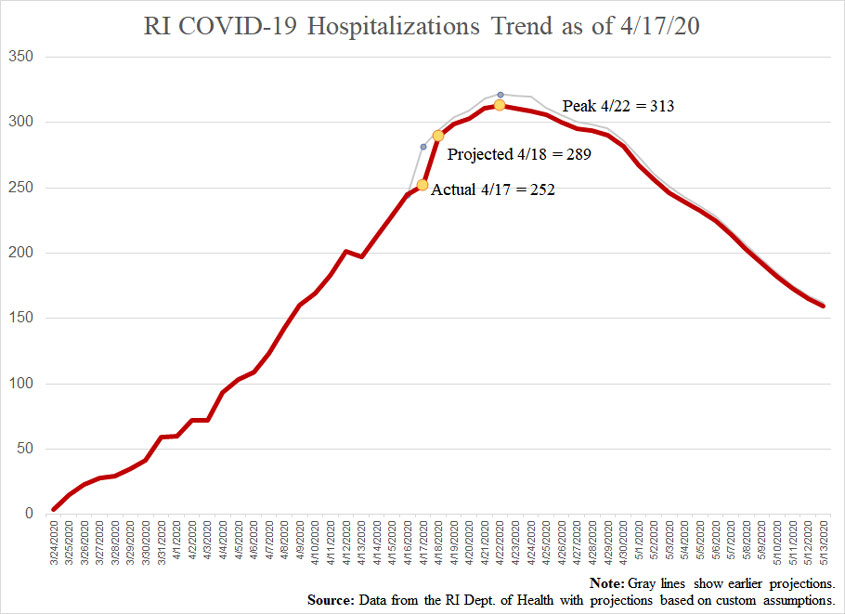
For the record, the underlying predictions that produce this line suggest that today the governor will announce:
As of this writing, the three models I’m tracking suggest the following change in hospitalizations:
Governor Raimondo announced that she was going to give Rhode Islanders more transparency into the data that she’s using to make decisions about the extent of our freedom during the COVID-19 wave, and even the RI Center for Freedom & Prosperity commended the intention. What Rhode Islanders actually got, however, wasn’t much transparency, but rather, an incomplete chart of a single metric without any description of the methodology.
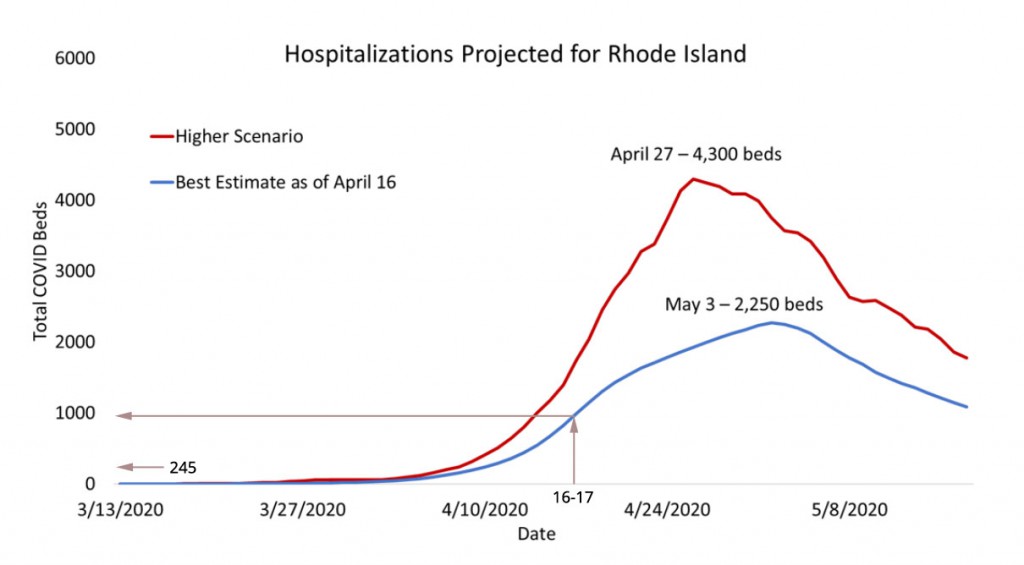
What’s conspicuously missing from this chart is a “lower scenario.” See, for example, the IHME model for Rhode Island, which has a worst-case scenario of 4,386 hospital beds needed on May 6, a “projection” of 942 on May 2, and a best-case scenario that has us already beginning to see a reduction.
Rhode Islanders shouldn’t hope for that outcome, but given how high the IHME’s projections have proven so far versus reality and how much higher the governor’s estimates apparently are than theirs, we should expect many fewer hospitalizations than she’s saying. It’s difficult not to conclude that she’s painting a bleak picture so as to mislead Rhode Islanders into better compliance with her directives. That’s especially true if you notice that the governor’s “best estimate” line appears to show nearly 1,000 people in the hospital today, when the actual number is 245.
As I’ve been saying, we are adults and deserve accurate information. We are not children who need an elected mother to coax us with phrases like, “I need you to be brave.”
Again, rates of growth have been slowing. Seventeen days ago, hospitalizations were increasing around 25% every day. That’s down to about 7% now. At the same time, the increase of total cases has been slowing, as has the percentage of all cases who are going to the hospital.
The question the governor apparently didn’t answer (and that apparently nobody asked) is why we should expect these trends to reverse such that the number of hospitalizations will be nine times higher in 17 days than it is right now. That would be an average of 15% increase every day. Why should we expect the rate of hospitalization to accelerate like that?
Maybe there’s some data out there that would give us reason to expect such an outcome, but we should know what it is, and the people who gave Raimondo her chart should be able to explain it to her.
Of all the deprivations that Rhode Islanders generally and Catholic Rhode Islanders specifically have had to endure during the past month or so, the inability to collect palms on Palm Sunday is not the biggest. That said, it is critically important to note that it was patently unconstitutional for Democrat Governor Gina Raimondo to direct that they not be provided:
Cranston Police Chief Michael Winquist confirmed Sunday that officers responded to St. Patrick’s Church after someone called to report palms were being given out.
“It turned out that the doors to the church were left open with a basket of palms left in the vestibule for parishioners to take one,” Winquist said in an email. “No clergy were present.”
He said police did not take any action, as Gov. Gina Raimondo’s directive not to hand out palms did not come with an official executive order.
Raimondo announced Friday there would be no distribution of palms for the holiday, which marks the start of Holy Week for Christians.
St. Patrick’s is not part of the Roman Catholic Diocese of Providence, so the suggestion of Bishop Thomas Tobin that parishes should comply with the “directive” did not apply. Within his scope, however, it would have been preferable for Bishop Tobin to assert that the ban on palms was his decision, not the governor’s, rather than just cede his authority to her.
If the First Amendment means anything when it comes to religion, it means that the governor cannot decide what religious implements are “essential.” Fundamentally, that is the government’s chief executive implementing her own religious worldview as the law (and her support for abortion proves that her worldview is not Catholic). Flowers from the grocer are permitted. Beer is permitted. Delivery of newspapers is permitted. Pickup of sporting goods, office supplies, and more is permitted.
In other words, Governor Raimondo isn’t only saying that palm branches distributed through churches are not “essential,” but that they are uniquely dangerous. Satan, no doubt, agrees.
This is a travesty against our Constitutional rights. The governor could ask religious leaders and individuals to (please) consider whether a particular implement or ritual is “essential,” but she cannot direct that it is or isn’t. If religious Rhode Islanders don’t protect this liberty during our slow-rolling crisis, we may never recover it.
One of the persistent questions surrounding this outbreak of the COVID-19 coronavirus is whether all of the people who had a bout of some mysterious flu-like illness in the two months or so before the world really started to pay attention to the disease have already had it. Writing on her Facebook page, Lisa Daft made the excellent observation that Rhode Island saw “a lot of negative flu tests this winter.”
The chart she displays comes from the RI Dept. of Health’s Influenza Surveillance page, which currently offers the following, with the gray sections representing tests that came back negative for the flu, presumably despite flu-like symptoms:
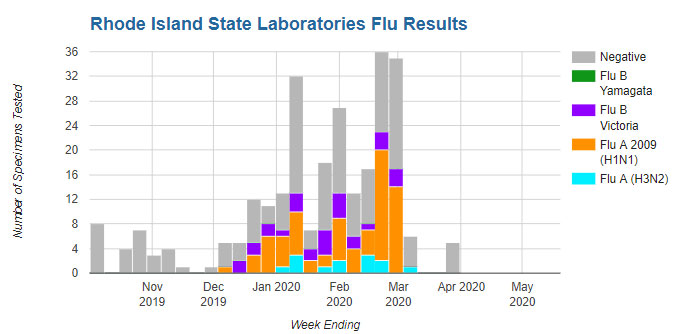
Can the number of those negative results actually be showing us early COVID-19 infections? Possibly, but finding the same chart in the last few years of the Dept. of Health’s annual report suggests these results aren’t actually unusual (2016, 2017, 2018, 2019). Here’s the one from two years ago:
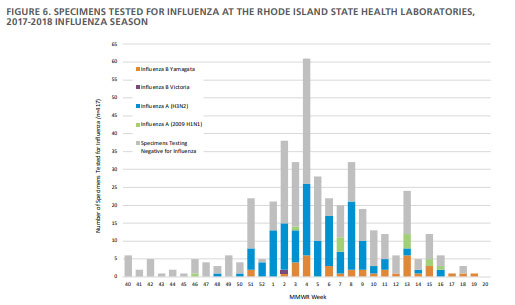
These trends are consistent with national experience. The following chart shows the number of flu-negative tests for the United States from October 2015 through January 2020, as reported by the World Health Organization:
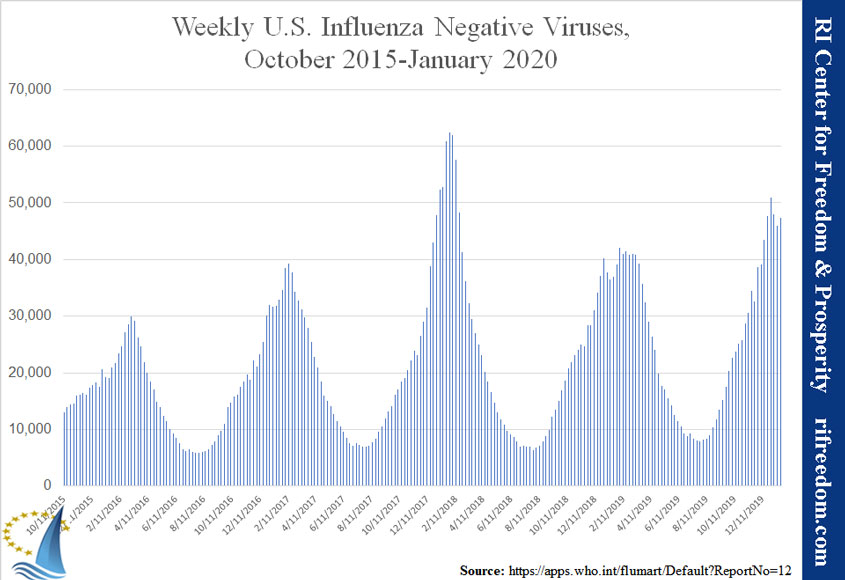
So, while negative tests during this flu season look like they’re going to prove to have been higher than average, they aren’t unusual, and this hasn’t been the worst year on record for negative tests. Of course, that doesn’t mean the strange illnesses so many people have reported were not COVID-19. Every year, the number of negative tests could be accounted for by something different, ranging from the amount of attention the media is paying to the flu to the severity of the flu season (making people more inclined to get tested) to an outbreak of some virus that is never identified.
The next question to answer would be how many deaths occur each year due to mysterious illnesses that initially present as the flu.
Here’s a clip from WPRI’s coverage of Democrat Governor Gina Raimondo’s latest daily COVID-19 statement that shows an absolutely unacceptable attitude from the governor:
Asked about the latest projections from the University of Washington — which now predict nearly 1,000 Rhode Islanders will die due to COVID-19 and the outbreak will peak in the state later this month — Raimondo said the school’s model has been updated after conferring with Rhode Island officials. She again declined to share the state’s own predictive modeling, but indicated she thinks the peak could be as late as mid-May.
“If anyone tells you they know exactly when Rhode Island’s peak is, and what the number of hospitalizations will be at that peak, they’re not being honest with you,” she said.
The governor is making decisions that have profound effects on our lives, including the exercise of direct executive authority to do things that would not normally be permitted in a representative democracy. She has an obligation to explain herself to the public. “Take my word for it; I’m the boss, and I have the best of intentions” is not good enough. (That’s a characterization, not a quotation, if you weren’t sure.)
How many deaths does the governor project Rhode Island will experience, and how many does she expect to avert by taking this or that action? These aren’t idle questions from a Don’t Tread on Me enthusiast. Every new restriction on our activity comes with a price-tag in health and lives. In rough numbers, Rhode Island experiences just under 400 suicides and drug overdoses each year; how much is poverty, isolation, and idleness going to drive up those numbers? Does the governor have a model for that?
Tough-gal talk about driving around the state and “you’re not going to want to be in that group” if she has to “break up any crowds” is (maybe) how you manipulate teenagers, not how you communicate with adults. Declaring a slow-rolling state of emergency for months on end does not make us subjects, and the governor’s legitimacy requires complete transparency so we can evaluate for ourselves whether her actions are justified.
Of course, it doesn’t help that our legislators are proving that they lack the courage to fulfill their role in our government during this tricky time.
Welcome to the world of social distancing. As a person-to-person strategy to slow a contagion, it’s absolutely reasonable, but it’s starting to sound like an ominous act by government to tear us apart.
Meet three golfers trying to walk the line between their state of Massachusetts, which closed golf courses, and the neighboring state of Rhode Island, which closed the state to outsiders who can’t quarantine for 14 days:
An Attleboro man and his two golfing partners are being charged with playing a round in Rhode Island in violation of a ban on people coming into the state for nonwork-related reasons. …
They were apprehended at a nearby McDonald’s restaurant, where police say the men changed cars to drive to the course in a vehicle with Rhode Island license plates.
Taunton and Attleboro, where the men are from, are part of the regular lives of Rhode Islanders. The quarantine restrictions don’t apply to Rhode Islanders who travel across the border or to people heading in either direction for work. In this case, the three of them came to Rhode Island to give a local business some money and to walk around a giant outdoor lawn for a few hours.
Perhaps in our current environment this outcome is a matter for reasonable debate (although some would surely say no debate is allowed and I’m wrong), but this seems to me to be an indication that we’re beyond the reasonable line.
As state and local governments take action to postpone various elections and grant themselves emergency powers (and abuse those powers), the people should keep an eye on an important deadline: the declaration of candidacy.
The state forces citizens who might run for office to declare their intentions by June 22-24 in an election year. While this gives plenty of time for campaigning (and opposition research by incumbents) and prevents political surprises, it also means that voters may not be able to hold elected officials accountable for anything that happens between late June and November, especially if the incumbents are running unopposed.
Even if the coronavirus crisis subsides in time to make it reasonable for people to collect signatures following their declaration, the public is still at a disadvantage. When it comes to potential candidates, they can’t be out there right now learning the landscape and getting a feel for their chances. When it comes to incumbents, the public is too anxious and preoccupied, right now, to adequately assess their actions (or lack thereof), and this atmosphere may remain until well after the COVID-19 cloud lifts.
As much as government may have a fair claim to increased flexibility during this time, the public deserves an opportunity for increased accountability as things get back to normal. If parties can replace their candidates into September (as we witnessed when Bob Healey jumped in at the last minute as the Moderate Party candidate for governor in 2014), the people should be able to have until then to decide whether incumbents deserve competition or other declared candidates are satisfactory as the only other choices.
This short March 14 ABC6 story by Nick Pappadia didn’t have much of a shelf life, but it’s worth noting because it is a good study of underlying assumptions underlying and the way in which a sense of what must be believed spreads:
Despite Governor Gina Raimondo’s advice, urging all Rhode Islanders to stay indoors as much as possible and to avoid crowds, Bishop Tobin has not officially cancelled Mass services for Catholic’s in Rhode Island.
On Saturday morning, Bishop Tobin released a statement requesting Catholics over the age of 60 not to attend Mass, and to refrain from receiving Holy Communion. There was no mention of him cancelling mass for all Catholic parishioners.
Governor Raimondo said, “I’d like to thank Bishop Tobin for his cooperation, and that it is within local pastor’s discretion to cancel masses on their own.”
Since then, we have learned that many local priests have taken matters in to their own hands and have cancelled Mass services at their individual parishes.
Bishop Tobin did not impose a restriction from the top down, and pastors who cancelled services were “taking matters into their own hands.” No, they were choosing one of the options open to them. The assumption appears to be that things are and should be typically dictated from the top down.
More deeply than that, notice the hierarchy in Pappadia’s construct: The governor to the bishop to the parishes. Fundamentally, this means there is no real separation of church and state, because the bishop is in some sense obligated to follow the governor’s “advice.” When he doesn’t do so, he is implicitly hinting that he prefers the opposite outcome, so when priests follow the governor’s advice rather than this supposed hint, they are actually rebelling… even though they’re acting within the bishop’s range of instructions.
Many fascinating perspectives are being revealed during these times.
Being in the car less, recently, I’ve fallen behind on podcast listening, so the episode of Changing Gears to which I listened while working out last night was a few weeks old. The guys were explaining the various reasons (having to do with materials, labor, and politics) that Rhode Island’s roads don’t last.
Not long afterwards, I was back at the computer and thinking (again) how far Internet technology has come in the past year… when the power went out. All the Zooming, podcasting, on-demand streaming, and other innovations that this viral crisis has made so critical to basic life fell of the table of social organization in an instant. On a clear night, the flow of electricity just stopped.
Growing up, I don’t remember ever losing power when the weather didn’t provide an obvious explanation, and it seems to be becoming more common in recent years. Every time it happens, I can hear a few more generators running, as my neighborhood adapts to this new reality over time.
While the world has been substantially shut down, I’ve also been catching up on reading legislation that managed to receive floor votes. Here’s one to ban disposable plastic shopping bags, and I note the news today that San Francisco has now banned reusable shopping bags to prevent spread of COVID-19. Another bill that didn’t manage to get a vote in the innocent days before the pandemic (House, Senate) would have criminalized the intentional release of balloons into the air.
Yes, while a virus was spreading around the planet bringing death and economic ruin, Rhode Island legislators were pondering a bill titled “Relating to Health and Safety – Balloons.”
Whether we’re talking about the roads or the power grid or the budgetary desperation we’re hearing from our elected officials, the message ought to be clear: Rhode Island has to get back to basics. Stop worrying about balloons. Stop micromanaging the economy. Stop confiscating tax money from people in order to fund superfluous things or pet projects.
This crisis is illustrating the necessity of government for a variety of functions, but it is also proving the need for government to do those critical things well. And that means focusing on them, including a halt to the drain of taxpayer money to things that just shouldn’t be priorities. Both basic government functions and private-sector activity are more important.
The legislative proposal by Warwick/Cranston Democrat state representative Joseph McNamara has made the news rounds, but it deserves a stronger point to be made. The press release says he’s “drafting new legislation that would help businesses hit hard by the COVID-19 crisis by guaranteeing that business interruption insurance would cover their losses regardless of policy language.”
It’s kind of a dishonest move. Insurance companies charge their clients rates based on the risk involved in their policies. These charges go toward a fund to cover the estimated payouts based on the risk for each thing that’s insured. There is competition in insurance just as there is in every other private-sector market, so companies can’t charge fees that are so high they’re disconnected from this relationship to payouts.
If the General Assembly and governor pass a law that requires insurance companies to pay for events that were deliberately left out of the calculation of risk, the insurance companies will have to find that money somewhere. One way or another, that means distributing the cost among other clients. The complications of reinsurance (insurance for unexpected insurance payouts), do not change this fundamental fact; they just mean the spread is broader.
If government officials want to insure Rhode Island businesses against a loss during a crisis, they should do it the more-honest way of using government funds. The legislature and governor should make the statement that this is a worthwhile priority and will therefore either displace lesser priorities or require tax increases.
Of course, cost comes at a political price, which politicians prefer to avoid. Thus, these sorts of mandates that make other people pay for government policies (aka hidden taxes) ensure that the McNamaras of the state can pat themselves on the back for giving away money while hiding the fact that it has to come from somebody.
Over on the blog of Rhode Island Women for Freedom & Prosperity, Judith Bowman describes her sense of the new normal, concluding thus:
Although we cannot change others, each of us has the ability to change ourselves. We have a responsibility to model appropriate language and behavior and lead by example. Americans have historically answered every call to action when the country’s well-being has been at stake. As we are diverted from our normal routines we must surely put partisan politics aside and continue to come together. As we practice and calibrate new communication approaches perhaps we could consider choosing more measured words to help restore emotional health and well-being, civility, respect and unity to our country.
We gratefully acknowledge the swift and decisive actions by our government leaders, physicians and health professionals, companies and corporations, friends, neighbors and perfect strangers and thank them for their prompt and tireless efforts, updates and generous spirit. They say, ‘out of every tragedy comes new strength.’ During this very challenging era in American history, we have a chance to not only heal the wounded and win the viral war but reinforce American exceptionalism merely by choosing more measured words and matching those words with actions.
This attitude is sorely needed. To be honest, it’s rattling to read some of the hostility, sometimes approaching glee, out there, particularly among progressives. A former legislator who has been filling his time accosting me on Twitter talks down any news that might potentially give people some hope that there’s light at the end of this tunnel. It is apparently catching on in certain circles to call COVID-19 “the Trump Virus.” Yesterday, Rhode Island Public Radio columnist Scott MacKay retweeted left-wing activist Barbara Malmet declaring the inevitable recession to be “Trump’s Great Depression.”
Who wishes such things on their country? Is there any concern or hope among such people around ever reconciling with their fellow Americans again?
It seems like a strange thing to remember more than thirty years on. I was probably eleven or twelve, walking through New York City with my parents. As usual, my mother was up ahead, driven to get wherever we were going, while my father meandered behind, absorbing the day.
I made eye contact with a girl about my age walking in the opposite direction, and she smiled. That’s the memory. A passing moment. A fleeting, ephemeral relationship.
As the movement swells on social media to make the constant wearing of masks part of our culture, even when this current madness has passed, I think of that momentary connection. We’re so isolated already. I was an only child, and there are more of those now, too.
I’m just not sure hiding our faces is something we should want to adopt as an expectation. If times require it, sure. If we had East Asia’s pollution problems, maybe. But the United States responded to the pollution problem by seeking to reduce pollution while keeping our faces exposed.
At the very least, let’s acknowledge the trade-off. If we could quantify a random smile in the isolating mass of a New York City street, what would it be worth? If I were in my eighties and facing the fear of viruses, would I trade a lifetime of such smiles and memories for a little bit less risk? And if I would, is that the attitude our culture should encourage?
To be sure, living otherwise entails risk. Yes, trying to fix the world’s illnesses so as to live free is more challenging.
A short online discussion I had along these lines centered around different notions of maturity. Is it more mature to be willing to give up a little bit of our freedom in order to provide ourselves and others a little more security, or to take responsibility for our own security so that others may live more freely?
The right answer is some balance between the two, of course, but this universal-mask idea seems also brings along a sort of deprivation. Hiding our faces doesn’t just impose a restriction on us; it also deprives others of the ability to see us, to see our smiles.
This view may be destined for decreasing tolerance as our expanding longevity increases our terror of risk, but my vote is for a humanity that strives to be closer rather than more isolated and accepts that not everything is possible to control.
Here’s some encouraging news out of London:
The British government is just “days” away from releasing 3.5 million self-administered finger prick tests that could prove a game-changer in easing the economic fallout from the coronavirus pandemic.
The tests will likely be stocked in retailers like Boots, a major pharmacy chain in the United Kingdom, and available to order online via Amazon, however the first stage of the rollout will be reserved for doctors, nurses and other essential workers.
At first, the tests would be held for critical personnel, but as more are produced, they’ll be available to the general public.
The article emphasizes that people who have the antibodies and are therefore inoculated can get back to work (and, implicitly, economically productive play). Of course, knowing that they haven’t yet built up an immunity will also help people make decisions about how isolated to make themselves.
This news speaks to a question many families have surely had upon hearing that Massachusetts Governor Charlie Baker has extended the ban on in-person schooling to May 4. Isn’t that an unnecessarily pessimistic step? Going forward, a vaccine would be the gold standard relief innovation, but that isn’t the only thing to watch for. Means of treating the effects of the virus (not only for individuals, but also for hospitals to handle large numbers of cases) are also in the works, and broad availability of tests for live infections and immunity would be hugely helpful in managing the epidemic.
The entire world is focused on this disease. We’ve already inculcated a sense of the importance of hygiene and social distancing, as well as a practice of self evaluation for symptoms. If we improve our knowledge about who is infected and who is immune, while we reduce the worst effects for individuals and hospitals or limit the populations who might experience them, restrictions could ease sooner than expected.
Of course, in a situation like this, we shouldn’t count on such outcomes, but we should leave open the possibility.